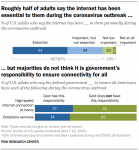The Pew Research Center is a jewel in the crown of social research, acting as a non-partisan “fact tank” without taking policy positions on issues. Through the years, it has produced valuable research on the internet and technology that I have highlighted more than a dozen times through the years, often adding that it is unfortunate no such institution exists in Canada.
In May, I referred to a dataset released by Pew that looked at perspectives on the internet based on research gathered in April, during the first month of the pandemic.
A couple weeks ago, IIC held a webinar looking at “American life in the midst of crisis”, featuring a discussion led by Lee Rainie, Pew’s Director of Internet and Technology.
I have embedded the 90 minute webinar here. Around the 26:40 mark, we are provided with some particularly interesting insights from data on Internet Use and Attitudes During the Crisis.
 Among the findings highlighted from the April data was a chart showing that 53% of Americans considered the internet to be essential, with another 34% saying it was “important, but not essential”. Ten percent said it was not too important and the remaining 3% said it was not important at all. Looking at these responses by demographic groups, we can see the influence of age, education, income and urban versus rural respondents.
Among the findings highlighted from the April data was a chart showing that 53% of Americans considered the internet to be essential, with another 34% saying it was “important, but not essential”. Ten percent said it was not too important and the remaining 3% said it was not important at all. Looking at these responses by demographic groups, we can see the influence of age, education, income and urban versus rural respondents.
Again looking at the April dataset, there were also charts that I found interesting on US attitudes on the role of government in ensuring all Americans have a home high-speed internet connection and cellphone during the coronavirus outbreak. Roughly two thirds of Americans felt that government did not have this responsibility.
Nearly 60% of lower income Americans surveyed in April said that their children would encounter at least one of the following problems in participating in online classes: having to use a cellphone for connectivity; having to use public Wifi (because there was no home internet connection); or, not having access to a home computer. Interestingly, 80% of Americans said that schools should provide computers to students during the pandemic: 37% said to all students; 43% responded only for students from families that could not afford it.
Contrasting the opinions on the role of government on broadband access versus the supply of computers, the analysis suggested that when kids were involved, more Americans felt government intervention was warranted.
In the discussion section of the webinar, we are told “it’s relatively easy to say in the abstract that broadband ought to be a human right, and that governments have a responsibility to provide it particularly in school contexts”, but “compared with the other things we want government to do, is this a high priority or not? For some people it really is, but for significant numbers of people, there are other ‘stressors’ in their lives or other public policy preferences that they have, that make them think that broadband is not necessarily a top-of-mind top priority.”
As Mr. Rainie says, it will be really interesting to see whether people’s priorities have shifted when Pew conducts its next survey on these issues.
As you playback the webinar, be sure to listen to the discussion for the ‘colour commentary’ that follows the initial presentation of the data. There have been shifts in attitudes over time, lending support to my perspective that we need to turn our minds toward examining digital literacy and demand side factors for adoption of broadband.
Looking at the treasure trove of information being gathered by Pew, once again I am reminded that we need more data to inform our policy making in Canada.
